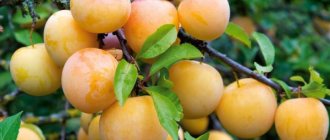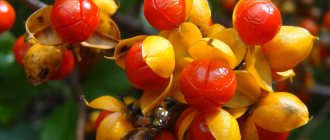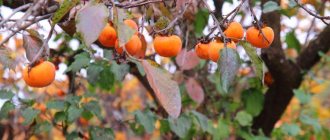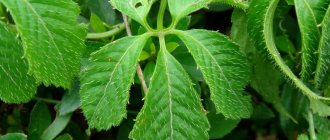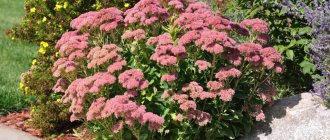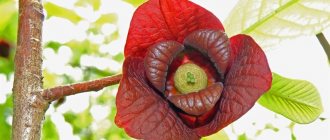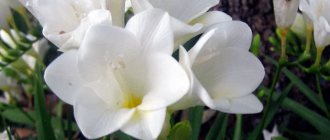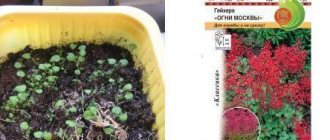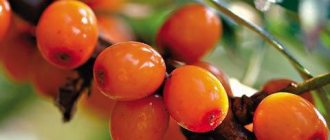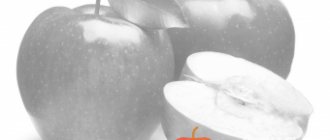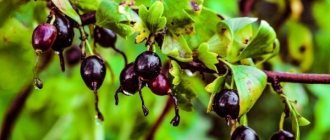Meaning and Application
Sea buckthorn juice, liqueur and jelly (Hiddensee, Germany)
Selection
In Russia, sea buckthorn was introduced into the culture of the Scientific Research Institute of Horticulture of Siberia on the initiative of M. A. Lisavenko, where over half a century, as of 2011, about 40 varieties were bred, including large-fruited varieties Augustina, Azhurnaya, Zhemchuzhnitsa and others; varieties of male plants optimized for flowering time and pollen quantity for effective pollination of female ones, such as Alei, Gnome.
Economic importance
Sea buckthorn fruits serve as raw materials for obtaining a food product - sea buckthorn juice, and the dried fruit pulp is used to obtain (by extraction with sunflower oil) sea buckthorn oil, used in medicine.
Sea buckthorn can also be cultivated as an ornamental plant with beautiful, olive-green leaves on top and silvery underneath. Suitable for creating hedges.
Due to its powerful root system, sea buckthorn is used to stabilize slopes, ravines, slopes and excavations of railways, highways and canals, to strengthen sandy soils and prevent landslides.
In veterinary medicine, sea buckthorn branches are used to accelerate the growth of wool in sheep and to give it shine.
The leaves can be used for tanning and dyeing leather. In the past, the fruits were used to dye fabrics and wool yellow, and black dye was obtained from young shoots and leaves.
The plant is wind-pollinated; its flowers have virtually no nectar. The so-called “sea buckthorn honey” in everyday life is a syrup made from sea buckthorn berries.
Use in cooking
Sea buckthorn fruits have nutritional value; they are eaten fresh and canned as a spicy-aromatic and spicy-flavoring additive.
Sea buckthorn juice is used to prepare pineapple-flavored sea buckthorn juice, puree, jam, marmalade, jam, and candy fillings. The juice is used to produce and flavor wine, soft drinks, liqueurs, and tinctures; fresh fruits, after freezing, lose some bitterness and are used to prepare jelly, tinctures and jellies.
Application in scientific medicine
Sea buckthorn leaves
Sea buckthorn leaves accumulate tannins, which are the active principle of the drug - hyporamin, which has antiviral activity. Hyporamin, obtained from sea buckthorn leaves in the form of lozenges, is used as a therapeutic and prophylactic agent for influenza (A and B), as well as in the treatment of other acute respiratory viral infections.
The oil has wound-healing and analgesic properties, it is used to treat scaly lichen, Darier's disease, burns, frostbite, eczema, ulcerative lupus, poorly healing wounds, cracks, some diseases of the eyes, ear, throat, as a vitamin remedy for hypo- and avitaminosis, peptic ulcer of the stomach and duodenum, radiation injuries of the body, as a prophylactic agent to reduce generative changes in the mucous membranes of the esophagus and stomach due to radiation therapy of tumors, as well as in gynecological practice for colpitis, endocervitis (Cervicitis) and cervical erosions. It has a nutritional, anti-inflammatory, regenerating and biostimulating effect, and is included in the preparations “Olazol”, “Gipozol” and “Oblekol”.
In cosmetics, nourishing masks are prepared from sea buckthorn oil, which accelerate epithelization and granulation of skin tissue; A decoction of fruits and branches is used for baldness and hair loss.
The seeds are used as a mild laxative. Externally, the fruits and oil of sea buckthorn are used for rashes, eczema, for the treatment of long-healing wounds, ulcers, and for women's diseases.
Use in folk medicine
The fruits and leaves of sea buckthorn were widely used in oriental (Tibetan and ancient Mongolian) medicine. In Russia, the fruits and leaves of sea buckthorn have also long been used in folk medicine.
In folk medicine, the oil is used internally for vitamin deficiencies (scurvy, night blindness), gastric and duodenal ulcers. The leaves in Central Asia are used externally for rheumatism.
Distribution and ecology
Botanical illustration by Jacob Sturm from the book Deutschlands Flora in Abbildungen
, 1796
In the wild, it is distributed throughout Europe, the Caucasus, Western and Central Asia, Mongolia, China, and enters the tropical regions of Pakistan and India. On the territory of Russia it is found in the European part, in the North Caucasus, in Western and Eastern Siberia, in Altai[1]. Thickets of sea buckthorn are usually confined to floodplains and lake shores.
It is grown in gardens and parks as an ornamental plant. The plant has become widespread in Russia. In the genus sea buckthorn, sea buckthorn is bred for its fruits; its selection is carried out and many varieties grown on an industrial scale have been developed, and in Russia, mainly in Siberia, where, according to the 2006 All-Russian Agricultural Census, more than 5 thousand hectares are occupied by its plantings [ 2].
Sea buckthorn is a light-loving and frost-resistant plant that can tolerate frosts down to 45 degrees and below. Sea buckthorn prefers loose soils rich in organic matter and phosphorus. In wet areas the plant dies.
The frost resistance of sea buckthorn allows it to be grown in the northern regions. After the healing properties of sea buckthorn fruits and oil were established, it began to be cultivated as a valuable vitamin plant and began to be grown in private plots and on industrial plantations.
Pests and diseases
Great damage to sea buckthorn crops in cultivation is caused by the sea buckthorn fly ( Rhagoletis batava
), damaging most of the fruits on each affected plant[2].
The leaves are affected by the fungi that cause verticillium wilt (wilt) Verticillium albo-atrum
and
Verticillium dahliae
and the relatively recently discovered sea buckthorn aphid (
Capithophorus hippophaes
)[3].
Varieties for Ukraine
The climate in most of Ukraine is much milder than in Russia. Accordingly, local gardeners can choose sea buckthorn varieties, focusing not on what is possible, but on what they want to grow. The defining characteristics in this case are the yield, the taste of the berries, and the presence of immunity against diseases and pests typical of the crop.
Elizabeth
Quite an old variety, bred in the 80s of the last century through chemical mutagenesis. The basis for the experiment was the seeds of sea buckthorn Panteleevskaya.
The bush is low, up to 2 m. The crown is sparse, almost regular spherical or oval in shape. The bark on adult shoots is brownish-brown. There are very few thorns. The leaves are small, concave.
Sea buckthorn Elizaveta was bred in Siberia, but is not particularly frost-resistant
The average weight of an elongated oval berry is 0.85–1 g. The skin is bright orange and thin. When torn from a branch, it is often damaged. The stalks are long. The berries, which literally cling to the shoots of most varieties of sea buckthorn, are located rather “loosely” on the branches of the Elizabeth bushes. The pulp is sweet and sour, very aromatic and juicy. The vitamin C content is low - 70–80 mg per 100 g.
Winter hardiness down to -20ºС, yield - 15–18 kg per bush. The fruits are valued for their versatility; they can also be eaten fresh. The variety does not make any special demands on soil quality and rarely suffers from diseases and pests.
Galerite
A variety of sea buckthorn that forms a very compact bush, and also does not differ in growth rate. Maximum height - up to 1.5 m. The crown is spreading, not thickened. The shoots are thin, curving.
The Galerit sea buckthorn bush is compact and can be planted even in the smallest garden plots.
The berries are ellipsoid, weighing about 0.8–0.9 g. The skin is shiny, pale orange, covered with spots of reddish-pink “blush”, mainly concentrated at the top and base of the fruit. The pulp is very dense, but tender and juicy, with a subtle bitter aftertaste.
The harvest ripens late, in the second ten days of September. Fruiting is stable, annual. The average yield is 10–12 kg per adult bush.
Essel
One of the latest achievements of breeders. The variety belongs to the early category; the berries ripen in the first ten days or closer to mid-August. The plant is tree-like, with a crown of a regular oval shape. There are almost no thorns.
Sea buckthorn dessert variety Essel is one of the latest achievements of breeders
The fruits are large, elongated, oval or egg-shaped, weighing 1–1.2 g. The skin is pale orange, the flesh is slightly darker. The pulp is very juicy and sweet, the sourness in the taste is almost invisible. The fruits are separated from the branches extremely easily. The average yield is 10–13 kg.
The variety belongs to the dessert category; the fruits can be consumed fresh. Winter hardiness is good, down to -25ºС. The berries are well suited for making juices.
Lady fingers
Also one of the new selections. The bush does not differ in size and growth rate. The fruits are elongated, weighing 1–1.3 g. The yield is low - 6–7 kg per bush. The taste earned the highest possible rating from professional tasters. A dessert variety, the purpose of the fruit is universal.
A new variety of sea buckthorn, Lady's Fingers, is considered the most delicious so far.
Diseases and pests, methods of control and prevention
Sea buckthorn has few enemies and is resistant to diseases typical of fruit trees. However, there are several ailments and pests that can not only deprive the gardener of a harvest, but also destroy the plant.
Dangerous diseases and pests are in Table 2.
table 2
| Diseases/pests | Symptoms/Harms | How to fight? |
| Scab | Spots and ulcers appear on the bark, leaves, and later on the fruits, and the plant dries out. | Pruning and burning diseased branches. Treatment with Nitrofen 3%. |
| Endomycosis | The fruits become wrinkled, and the disease gradually covers the entire plant. Dry berries retain fungal spores. | In spring and autumn - spraying with Bordeaux mixture. When diseased berries appear, collect and destroy. |
| Fusarium wilt | Leaves and young shoots wither. Berries and leaves fall. | Timely thinning of bushes. Maintain intervals between bushes when planting. Pruning and burning diseased branches. |
| Spider mite | A small, invisible insect. Affects buds and buds. The leaves are entangled in cobwebs. | Spraying with Fitoverm, Aktara and similar insecticides. |
| Aphid | A small insect that sucks juices from a plant. The leaves and tops of the shoots curl and a continuous layer of insects is visible on them. The plant is weakening. | Destruction of ants that carry aphids. Treatment with Fitoverm and ammonia solution. |
Botanical description of the variety
The height of the plant can reach 3 m, the red-brown bark of which is covered with white hair. Quite often used by gardeners to obtain valuable berries. The variety and its distinctive characteristics will be discussed in more detail below.
Bushes and leaves
Chuyskaya sea buckthorn is a small multi-stemmed bush, the crown is sparse, rounded, and does not tend to thicken. The branches that form the “skeleton” are visually distinguished by their total mass of shoots. The leaves are narrow, alternate and have a pointed shape, resembling lancets. On this year's branches the color of the foliage is quite dark, and on last year's branches it is pale green, in both cases there is a silvery tint. There are very few spines and they are weakly expressed.
Read the description of sea buckthorn variety Jamovaya.
Flowers and perianth
Sea buckthorn flowers are small, with yellow-green petals. The female specimen of the tree has a lot of them, they can even hide in the axils of the thorns, but in the male specimen they are collected in small inflorescences. Flowering time falls at the end of April - beginning of May. The perianth is simple, with one pistil and four stamens. In male species the receptacle is flat, while in female species it is tubular.
Video: sea buckthorn Chuyskaya
Fruit
The size and quality of the berries are directly affected by the region where they are grown, as well as the care conditions. Often the color is deep orange, and the fruits themselves are elongated, round-cylindrical, and shaped like eggs. The smell is quite pronounced, pleasant, and the taste is characterized by acidity and sweetness at the same time.
Important! The quality of berries and yield directly depend on watering. With a lack of moisture, the berries become smaller, and the plant bears fruit about 2 times less.
When and for how long does it bloom
Inexperienced gardeners may not even notice sea buckthorn blooming. The flowers of the plant are small, inconspicuous, without petals. Externally, the buds of female plants look like yellow worms located at the base of the leaves. Male plants bloom their dirty silvery green flowers 1–2 days earlier.
The small flowers of the sea buckthorn bush are greenish-brown or yellow-green in color.
The beginning of sea buckthorn flowering depends on the region and air temperature.
- In the middle zone - in the first ten days of May.
- In Siberia and the Urals - closer to the beginning of summer.
- In the southern regions, the first flowers may appear as early as early April.
Flowering duration is 7–12 days.
Appearance
Sea buckthorn is a large, voluminous shrub that grows quite slowly, but can grow to about 4-6 m in height, with a crown diameter of about 3-5 meters. It has irregular, asymmetrical cover and spreading, tight, woody branches that are covered with smooth, brownish bark. The branches are covered with thin, hard and quite sharp thorns. Sea buckthorn forms dense, tangled thickets, and thanks to the numerous shoots of the root system, this shrub grows quite widely.
Sea buckthorn is a seasonal plant. The leaves develop in the spring and are an interesting decoration of the plant - gray-green above, silvery below, delicately covered with villi, 7 cm long, narrow and hard.
The flowers appear even before the leaves develop (March-April); they are small, yellow-green, have a rather characteristic smell, but do not have too much decorative value. Sea buckthorn is a dioecious plant, there are male and female specimens. Fruits appear only on female individuals, but in order for it to become dusty, at least two types of shrubs must grow at a close distance from each other. After pollination, fruits appear on the female bushes - small, spherical, orange drupes that begin to ripen in August, but they will only fully ripen in October. Sea buckthorn fruits are edible, but they can only be collected after the first frost (previously very tart). Gloves must be used during harvesting due to the thorns. If they are not collected, they will hang on the bush until spring, providing food and delicacy for birds. Sea buckthorn is directly covered with fruits; it is also an interesting decorative element in the garden.
Care procedures
Newly planted bushes need to shorten their shoots so that the plant produces new shoots and thickens well - we do this in early spring. A few years after planting, sea buckthorn can be formed in this way. Later, the bushes are not pruned because they recover very poorly. We cut out only dry, broken, damaged branches.
Sea buckthorn grows rapidly and over time can choke out other plants, so it is worth systematically removing the root shoots with which it quickly multiplies. The shoots should be pulled out rather than cut off. We do this in late autumn or early summer, when the young roots have not yet become woody.
The shrubs are quite resistant to pests , but sometimes aphids or mites . Weaker plants can be infected with diseases such as fusarium and verticillium.
Sea buckthorn can be propagated by seeds (generative propagation), from root cuttings or shoots (vegetative propagation). We sow the seeds in the ground in the fall or keep them (stratify them) and sow them in the spring. After 3-4 years it will be possible to separate the male individuals from the female ones (when they begin to bloom).
the root cuttings , cut them off (the bush takes root quite shallowly), and then cut them into smaller pieces and place them in penetrating soil, which should be constantly slightly moist. Newly emerged plants are planted in the ground in the spring.
vegetative shoots at the beginning of summer; they should be about 15-20 cm long and have several leaf buds. We place them in a mixture of sand and peat, the mixture should be constantly slightly damp, in a bright place, but not in the full sun. We will plant them in the ground next spring.
Peculiarities
Sea buckthorn is a perennial plant. This is a dioecious tree that can grow up to 4-5 meters in height.
The main feature of this plant is the presence of thorns, which complicate harvesting. It is advisable to wear thick gloves to avoid scratching your hands. Most fruit trees do not have such a defense mechanism. Many branches grow on the trunk, which are densely covered with hard and sharp thorns about 2 centimeters long.
Sea buckthorn bark has a grayish-brown tint. The foliage is linear-lanceolate, entire-marginal, about 8 centimeters in length. They have a light green color with a silvery tint, like an olive tree.
When the tree begins to bloom, the flowers have different colors. Male specimens are dark brown in color. Each flower can have 4 pistils, all inflorescences are collected in a “spikelet” of 10-15 pieces up to one centimeter long. Unlike husband. signs of flowers, females have stamens. They have a greenish color, and the inflorescences are collected in clusters of several pieces. Flowering begins in late April and early May.
The fruits of sea buckthorn are light green in color before ripening. After ripening, bright orange color. The drupes are usually oval-shaped and small. But they cover the branches so tightly that they may not be noticed under a large number of fruits. One mature tree can collect several buckets of berries. Fruit ripening ends towards mid-autumn.
Usually, buckthorn can be found in Europe and Asia, as well as in Transbaikalia, Altai, the Caucasus and even in the southern territories of Siberia.
Sea buckthorn grows very well even in the wild, so it is capable of creating entire impenetrable thickets in the natural environment. Grows well in sandy soil, in river valleys, near rivers. You can practically not care for these trees, since they themselves quickly adapt to the climate, and they can take water from underground.
Sea buckthorn can be propagated by seeds, root cuttings or seedlings.
Origin
Sea buckthorn, or buckthorn (lat. Hippophaë rhamnoídes) is a shrub or tree that belongs to the Sucker family. It grows naturally in Europe and Asia. These plants are resistant to frost, drought, wind, polluted air, and are also not demanding to grow. Sea buckthorn can also be used as a garden plant - it has decorative, silver-gray leaves, bright (and healthy and tasty) fruits, and can also be used to create hedges and to strengthen the slopes and slopes of the site. Sea buckthorn is sometimes called “Russian pineapple”. It has a very exotic, original appearance.
Application and beneficial properties
Sea buckthorn is suitable for dense, thorny hedges. Looks beautiful in large gardens or forested areas, in urban plantings. It has decorative silver leaves and very decorative, bright orange edible fruits. Sea buckthorn fruits contain vitamins (A, group B, D, E, F, K, P, a lot of vitamin C, which does not break down during cooking, because the plant does not have enzymes that break down this vitamin), minerals (boron, manganese, iron), as well as sugar, carotene, folic acid, tannins, anthocyanins and much more. Sea buckthorn can be used for diseases of the digestive system
(stomach, liver), respiratory system, skin disease
. Has a beneficial effect on the immune system and also counteracts skin aging
(seed oil). Medicinal raw materials are fruits and seeds (oil).
The fruits are juicy and aromatic, become sweeter after frost, suitable for jam, marmalade, marmalade (contain a lot of pectin), puree, jelly, juice, liqueur. They can also be dried.
If you have something to add, please be sure to leave a comment.
Describing sea buckthorn, let's consider its flowering: it is expressed by single-covered, regular-shaped flowers, each of them is endowed with a tubular two- or four-lobed perianth.
Each flower contains from four to eight stamens.
- Sea buckthorn fruits affected by endomitosis begin to lose their aroma and will easily become crushed in the hands when picked. In the coming year, such trees will produce almost no berries. You need to get rid of this disease with chemicals: Bordeaux mixture or copper oxychloride. The initial treatment is carried out after the end of flowering of the crop, repeated treatment - in mid-summer.
- A disease such as scab occurs everywhere; it provokes drying out of the shoots. If the scab has developed extensively, then the plant cannot avoid death. The disease affects foliage, fruits and young shoots. It appears in the first half of summer and has the appearance of rounded shiny spots of coal color; they increase in size until the end of the summer days. A little later, pink-yellow piles of mucus appear. This is a debate. They come out through the gaps of the berry skin. This process causes the fruits to rot, they turn black and dry out. The foliage curls at the ends, becomes brown, and black swellings appear on the shoots. You should get rid of this scourge by resorting to autumn pruning and irrigation with Bordeaux mixture, which has a concentration of one percent. Only this must be done no later than three weeks before the start of harvesting.
The most important enemies of sea buckthorn are sea buckthorn moth and sea buckthorn fly. They propose to fight them with chlorophos; they need to irrigate the plants at certain times.
The sea buckthorn aphid is considered an unpleasant harmful insect; it, together with the larvae, can infect plant leaves. In homestead areas, they fight it with infusions and decoctions of tomato and potato leaves, garlic and onion peels, as well as tobacco leaves mixed with laundry soap. In addition, a chemical method using karbofos at a concentration of ten percent is effective in combating aphids.
Subsequent care of the crop
The fact that sea buckthorn is an unpretentious crop does not exclude caring for it.
Necessary activities
Young sea buckthorn plantings are watered. In the future, the tree requires watering in dry weather in summer and autumn. The trunk circles of sea buckthorn are tinned by mowing the grass as it grows. The resulting root growth is removed.
Bushes that are well fertilized during planting are not fed during the first years. A fruiting plant needs phosphorus and potassium. For 10 liters of water add 1 tbsp. a spoonful of potassium and 2 tbsp. spoons of double superphosphate. It’s good to add 2 tsp. "Uniflor-micro". This cocktail is poured into one bucket under each tree.
Shrub pruning
In early spring, sanitary pruning is carried out. Remove dry, broken, diseased branches. The shoots that thicken the crown are cut out. In mid-summer, branches that have not shown growth are cut out.
At the age of 5 years, activities are carried out to rejuvenate the tree. In autumn, old branches are cut out at the base, which give a low yield. One branch is cut per year.
The main pruning of sea buckthorn is done when it is formed into a bush or tree. To obtain a bush, shoots from the shoots are allowed to develop. Their number is increased to 8, and then the 3-4 strongest are left.
Forming a tree from sea buckthorn is a complex process. It lasts 3-4 years and is not always successful. It is better to form male species with a tree, and to grow female species as a bush.
Preparing for winter
In preparation for winter, water-charging watering of the bush is done in case of dry autumn. Sea buckthorn does not require winter shelter. Only the roots of young seedlings are mulched.
In the photo you can see what the sea buckthorn Frugana looks like.
Planting sea buckthorn
The planting order does not differ too much from that generally accepted for this type of plant. Planting is carried out exclusively in groups, because to obtain a harvest, not only female but also male trees are needed. However, keep in mind that they grow quite tall, but the annual growth is small.
When is the best time to plant
Most often, planting is done in early spring, when the movement of sap has not yet begun. In the fall, the procedure is only resorted to in the south, since in areas with a harsher climate the plant runs the risk of not taking root before frost sets in. Sea buckthorn with a closed root system is suitable for planting in any season except hot summer.
If the recommended timing is ignored, young stems should be buried before spring. To do this, you need to dig a ditch, the depth of which will be approximately 0.5 m, while setting the direction of the crown to the south. Cover the roots with soil, and with the onset of frost, cover the seedlings, leaving only the top part outside. Next, spruce branches are laid, and with the first snow, additional insulation is built from natural material.
Selecting a location
It is necessary to plant a tree in an open area, where there is a lot of sunlight, and the distance from other plants is at least 3 m. In addition, it is undesirable to have beds nearby - when digging them, there is a possibility of damaging the root system, since it lies shallow.
Did you know? Due to its juiciness and taste, sea buckthorn in Russia received the name “Siberian pineapple”.
Soil preparation
It is best to prepare planting holes in advance. The soil dug out during the process must be preserved to create a nutritious soil mixture, which is subsequently sprinkled on the rhizome.
For preparation use:
- compost or manure - 1 bucket;
- washed river sand or pebbles - 1 bucket;
- earth removed during the formation of the depression - 2 buckets;
- wood ash - 0.5 buckets;
- phosphorus fertilizer (superphosphate) - 0.2 kg.
All components are thoroughly mixed until smooth and used directly in the planting process.
Selection and preparation of planting material
The best choice would be annual and biennial seedlings - by this age their height should be about 30–50 cm, and the root length should be at least 20 cm
It is important to pay attention to the bark - it should not peel off or have a dark brown color, as this indicates damage caused by frost. Before planting, seedlings are dipped in a clay mash, which is very easy to prepare.
Important! If the roots of the plant have dried out, before carrying out the procedure, place the rhizome in a bucket of water for a day or two so that they become elastic.
Required ingredients:
- water - 1 bucket;
- clay - 300–400 g;
- earth - approximately 500 g;
- wood ash - 0.5 l.
A suitable place is selected on the site where a small hole is dug. A bucket of water is poured into it, gradually mixed with the dug up soil and clay so that the consistency resembles sour cream. Next, add ash at the tip of a shovel and mix everything. The mixture is ready, you can immerse sea buckthorn bushes in it.
Algorithm and landing scheme
Sea buckthorn can be planted either in rows or in random order. In order for pollination to be high-quality, it is worth maintaining the proportion of male and female trees - 1 to 5, but no more. Most plant growers, on the contrary, reduce the ratio, since male species die more often. Therefore, they are recommended to be planted on the windward side of the group or surrounded by female specimens. The best pollinator will be a male bush of an identical variety.
The distance between the holes for planting must be at least 2 m; a rod is installed in the bottom of each, with a slight shift from the center, to which the seedling will subsequently be tied
It is deepened, the roots are carefully straightened and covered with a nutrient mixture, carefully compacted so that there are no voids. It should be noted that in the end the root collar should be 6–8 cm above ground level
After all manipulations, abundant watering and mulching with hay or sawdust are carried out.
Choosing a location and planting methods
The best place for planting sea buckthorn is a sunny corner of the garden, free from tall vegetation. Culture does not like being near trees. You should also not place sea buckthorn next to high, solid fences or buildings. Bushes planted in the shade grow slowly and gradually begin to die.
The roots of sea buckthorn spread laterally for more than 10 m, so you should not plant it next to areas that need to be dug. Systematic injury to the root system can lead to the death of the plant.
Pharmacological properties
Leaves, bark, branches, berries and seeds of a sea buckthorn bush or tree are used as medicinal raw materials. The leaves and young branches of sea buckthorn contain tannins, dyes, and flavonoids. The bark contains a high percentage of alkaloids, the fruits contain sugar, organic acids, fatty oil, vitamins B, P, PP, K, C and F, carotene, folic acid, pigments, flavonoids and tannins. Sea buckthorn flowers contain a lot of essential oil. The seeds contain fatty oil, tannins, vitamins B1, B2.
Sea buckthorn oil is extremely useful because it has the following qualities: it acts as an anti-inflammatory, epithelializing, bactericidal, granulating and analgesic agent. It is used to treat radiation skin lesions, bedsores, frostbite, burns, eczema, cutaneous TB, lichen, trophic ulcer, purulent acne, inflammation of the lips with pus and cracks, nasopharynx, female diseases (endocervicitis, colpitis, cervical erosion, ectopic epithelium ).
Sea buckthorn fruits are included in the medical diet. They are recommended to be used for peptic ulcers, vitamin deficiency or hypovitaminosis, after infectious diseases, as a means of strengthening the immune system, and after complex operations.
The juice of fresh sea buckthorn berries is used externally for erosive skin lesions and ulcerative skin lesions. And to enhance the therapeutic effect, it is recommended to take the berries orally at the same time.
Sea buckthorn bark also has valuable therapeutic properties. Alcoholic extract of sea buckthorn bark has high anti-protective activity and can significantly inhibit tissue growth. This is due to the action of serotonin, which is contained precisely in the bark of the sea buckthorn tree. That is why an alcoholic extract of the bark is always prescribed for radiotherapy in the treatment of malignant tumors.
Since sea buckthorn fruits represent a whole multivitamin complex, they are recommended to be used as a preventive measure for diseases of the immune system.
Plant raw materials
Collection and processing
Fresh fruit (lat. Fructus Hippophaes rhamnoides recens) is used as a medicinal raw material. The fruits are collected by “sniffing” the branches during their ripening, when they acquire a yellow-orange or orange color, are elastic and are not crushed when collected. Less commonly, fruits are collected by shaking frozen fruits from plants[5].
Frozen fruits retain vitamins for 6 months.
Chemical composition
Ripe fruits of sea buckthorn
The fruits of sea buckthorn are considered multivitamins. They contain provitamins A (up to 10.9 mg%) and vitamins (B1, B2, B3, B6, , , etc.). The fruits contain 3-6% sugars (glucose and fructose), organic acids (up to 2.5%) - malic, tartaric, etc., tannins, yellow coloring pigment quercetin, fatty oil (9% in pulp, 12% in seeds ). The leaves and bark contain the alkaloid hippophaine (up to 0.4%), ascorbic acid and up to 10 different tannins; in the bark - up to 3% fatty oil of a different composition than in fruits and seeds.
Fatty oil accumulates in fruits, which consists of triacylglycerols with saturated and unsaturated fatty acids, among the latter monounsaturated (palmitooleic, oleic) acids predominate; pectin substances, organic acids, tannins, flavonoids, nicotinic and folic acids, macro- and microelements (boron, iron, zinc, copper, manganese, potassium, calcium), sugars and some types of plant antibiotics.
The oil from the fruit pulp is bright orange in color, while the oil from the seeds is yellowish. Oil from seeds and pulp differs slightly in composition. Oil from the fruit pulp contains up to 0.350% carotene and carotenoids, thiamine and riboflavin, a fairly large amount (0.165%) of tocopherol and a significant amount of essential fatty acids.
Properties of sea buckthorn - harm and benefit
Useful properties of sea buckthorn
Not only the fruits of sea buckthorn, but also its leaves and branches have medicinal properties. Sea buckthorn contains oxalic, tartaric and malic organic acids, vitamins C, B1, B2, PP, K, E, carotene and carotenoids, flavonoids, manganese, boron and iron, tannins, phytoncides, oleic and linoleic fatty acids.
Sea buckthorn fruits contain serotonin, which is of great importance for the normal functioning of the human nervous system, as well as beta-sitosterol, which has an anti-sclerotic effect. A decoction of sea buckthorn berries is indicated for stomach and duodenal ulcers. Frostbite, burns and ulcers are treated by applying fresh berries. For men over forty years old, sea buckthorn berries are indicated as a means of increasing potency.
The leaves and fruits of sea buckthorn remove oxalic and uric acid from the body; an infusion from the leaves of the plant is used in the treatment of gout, rheumatism and diabetes. A decoction of sea buckthorn leaves and branches is prescribed for gastrointestinal disorders. Dry leaves are brewed as tea for scurvy symptoms.
But perhaps the most valuable product is sea buckthorn oil, which has a strong bactericidal effect. It contains vitamin E, vitamin F, which regulates metabolism in the skin, sterols, trace elements and minerals silicon, silver, copper, vanadium, nickel, manganese and cobalt. The oil is used both externally and internally. Its action increases the amount of protein in the liver, improves lipid metabolism, and stimulates regenerative processes in damaged tissues.
For chronic pharyngitis and laryngitis, sea buckthorn oil is used to lubricate the oral mucosa and is used for inhalation. Dermatologists recommend using sea buckthorn oil to enhance hair growth that has fallen out as a result of certain skin diseases.
Preparations created on the basis of sea buckthorn oil can greatly improve the body’s tolerance to antitumor drugs, and sometimes even enhance their therapeutic effect. To strengthen the child's immunity, nursing mothers are recommended to add a few drops of sea buckthorn oil to the baby's milk from the age of one month.
Sea buckthorn - contraindications
Can sea buckthorn cause harm? Since its berries contain a lot of carotene, sea buckthorn can cause an allergic reaction in people with reduced immunity. Due to the presence of a large amount of acids in the berry, it is not recommended to consume sea buckthorn for people suffering from liver disease, pancreatitis, cholecystitis and inflammation of the duodenum, especially if the disease is in an acute stage. A tendency to loose stools is also a contraindication. Since the berries increase the acidity of urine, consumption of sea buckthorn is not recommended for patients with urolithiasis. Sea buckthorn is also dangerous for those who suffer from its individual intolerance.
Rationing of grape harvestTreatment of strawberries from pests
After this article they usually read
Add a comment
Botanical description of sea buckthorn
Hippos phae is a very colorful culture, distinguished by characteristic features. She is part of the Oblepikha genus, the Lokhov family. It is especially easy to recognize the plant when the berries are ripening. They turn yellow or orange.
The structure of sea buckthorn. Aerial part: 1 - root collar; 2 - trunk; 3 — branch of the first order of branching; 4 — branch of the second order of branching; 5 - branch of the third order of branching (fruit-bearing branch); 6 — branch of the fourth order of branching (growth of the current year)
The crop is considered a dioecious tree-like shrub. Sometimes there are trees too. There are sharp thorns on the branches. The plant can grow up to 5 m in height and diameter. It is characterized by hardened branches and dark brown bark.
Find out also how to quickly and correctly collect sea buckthorn.
The leaves are linear-lanceolate, light green above, silvery-white below. Grows on short cuttings. The length of some sheets can reach 7 cm.
Waxwort grows wild on the European and Asian continents. Pakistan, India, the Caucasus, and Siberia are also considered to be where it grows. Most of all, the plant loves moist soils near lakes and rivers. For propagation, botanists use seeds, root shoots, and cuttings.
Pay attention to the information on how to graft sea buckthorn onto sea buckthorn.
Requirements for air temperature and soil
Sea buckthorn is an undemanding plant that can adapt to various conditions. It easily tolerates heat up to 40 degrees and severe Siberian frosts.
In the presence of sun, the plant can survive in any soil, but in areas with heavy clay soil it will grow very slowly. Sea buckthorn needs light, dry soil, preferably with a predominance of sand. In waterlogged soil in swampy areas, the roots of the shrub will begin to rot.
Recipes
The fruits of sea buckthorn can be used in different forms, as you like - the benefits will not be less:
- fresh - as an addition to salads and baked goods;
- ground with sugar (proportion 1:1) with and without pasteurization;
- in the form of puree (the berries are heated in a small amount of water to a temperature of 50 degrees, ground through a sieve, sugar is added, pasteurized and rolled);
- in the form of juice with or without pulp, as well as in a mixture with the juices of honeysuckle, raspberries, and blueberries.
The calorie content of the product is 82 kcal per 100 g of fresh fruit. As a vitamin booster that strengthens the immune system, berries are most easily consumed as an additive to hot drinks. For example, for bronchitis with a persistent cough, it is good to drink sea buckthorn tea with ginger and honey.
An infusion is prepared from the leaves to normalize blood sugar levels. To do this, pour a teaspoon of crushed leaves into a glass of boiling water, leave for half an hour and filter. Take 10-15 ml twice a day.
A mixture of 1 kg of fruit, 200 g of sugar and 1 liter of quality vodka turns into a tincture to support immunity. Infuse the berries for a month, take 20-30 ml per day.
There are many recipes for sea buckthorn face masks:
- yolk, butter and berry juice;
- protein, cottage cheese and butter;
- protein, white clay, berry puree;
- starch, sour cream, puree.
Beat the protein in the masks, add the remaining ingredients, mix, and apply to the face from bottom to top. The result is skin rejuvenation, improved blood supply, and smoothing of wrinkles.
Sea buckthorn recipes
Sea buckthorn ripens slowly and requires labor and patience during harvesting. But her sunny berries are worth it: each of them is a vitamin bomb that can blow up a cold and leave no stone unturned against the infections that cause it. Place a large bag of golden fruits in the freezer - just a few pieces a day will quickly and for a long time boost the immunity of the whole family.
Collection and processing
Leaves - for medicinal purposes, are harvested in May. The fruits are harvested after ripening - in September-October, when they become yellow (orange) and elastic. Collection is carried out only in dry weather. The collected fruits are cleaned of debris, unripe and diseased specimens.
Sea buckthorn is often harvested after frost, when the fruits can be easily shaken from the branches. If there is only one bush, then you can pick the berries manually; if there are several bushes, then you cannot do without mechanical devices. To collect sea buckthorn fruits, forceps, slingshots, and special “harvesters” are used - all this can be bought in a store or made independently.
Sea buckthorn fruits are used to make butter, they are dried, frozen, made into jam, compotes, and ground with sugar. Fresh fruits are placed in wooden barrels, frozen fruits are placed in bags. Fresh sea buckthorn is stored in a cool place for no more than 3 days; frozen sea buckthorn can be stored in freezers for up to six months.
Sea buckthorn oil is especially valued. It is prepared like this:
- Carefully squeeze the juice from ripe fruits.
- The pomace is dried in an oven (dryer) at 50 °C.
- Dry pulp is ground in a coffee grinder or mortar.
- Pour the ground pulp with vegetable oil in a ratio of 1:15.
- Insist for 3 weeks. Drain the liquid and the oil is ready.
